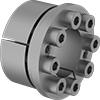Filter by
ID
Shaft Diameter
System of Measurement
Mounted Bearing Type
Ball Material
Bearing Seal Type
For Load Direction
Cage Material
For Bearing OD
Thickness
Plain Bearing Type
Ball Bearing Profile
Static Thrust Load Capacity
DFARS Specialty Metals
RoHS
Power Transmission
Fabricating and Machining






























